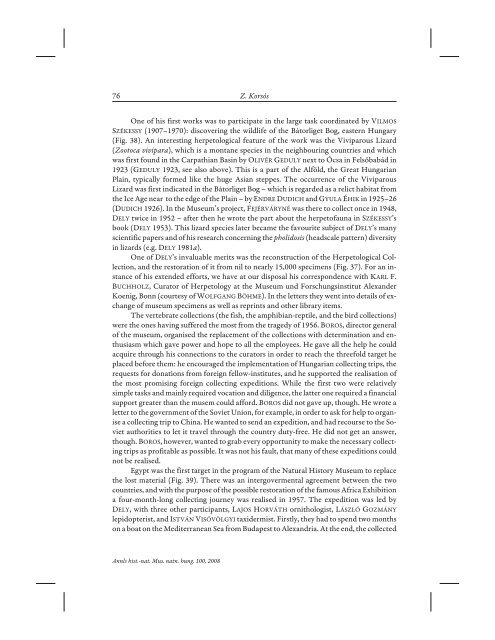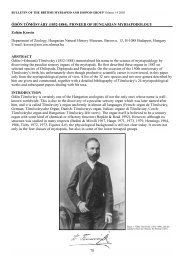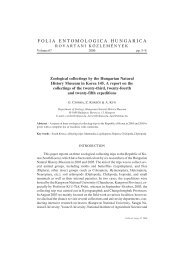History of the Herpetological Collection of the ... - Korsós Zoltán
History of the Herpetological Collection of the ... - Korsós Zoltán
History of the Herpetological Collection of the ... - Korsós Zoltán
Create successful ePaper yourself
Turn your PDF publications into a flip-book with our unique Google optimized e-Paper software.
76 Z. Korsós<br />
One <strong>of</strong> his first works was to participate in <strong>the</strong> large task coordinated by VILMOS<br />
SZÉKESSY (1907–1970): discovering <strong>the</strong> wildlife <strong>of</strong> <strong>the</strong> Bátorliget Bog, eastern Hungary<br />
(Fig. 38). An interesting herpetological feature <strong>of</strong> <strong>the</strong> work was <strong>the</strong> Viviparous Lizard<br />
(Zootoca vivipara), which is a montane species in <strong>the</strong> neighbouring countries and which<br />
was first found in <strong>the</strong> Carpathian Basin by OLIVÉR GEDULY next to Ócsa in Felsõbabád in<br />
1923 (GEDULY 1923, see also above). This is a part <strong>of</strong> <strong>the</strong> Alföld, <strong>the</strong> Great Hungarian<br />
Plain, typically formed like <strong>the</strong> huge Asian steppes. The occurrence <strong>of</strong> <strong>the</strong> Viviparous<br />
Lizard was first indicated in <strong>the</strong> Bátorliget Bog – which is regarded as a relict habitat from<br />
<strong>the</strong> Ice Age near to <strong>the</strong> edge <strong>of</strong> <strong>the</strong> Plain – by ENDRE DUDICH and GYULA ÉHIK in 1925–26<br />
(DUDICH 1926). In <strong>the</strong> Museum’s project, FEJÉRVÁRYNÉ was <strong>the</strong>re to collect once in 1948,<br />
DELY twice in 1952 – after <strong>the</strong>n he wrote <strong>the</strong> part about <strong>the</strong> herpet<strong>of</strong>auna in SZÉKESSY’s<br />
book (DELY 1953). This lizard species later became <strong>the</strong> favourite subject <strong>of</strong> DELY’s many<br />
scientific papers and <strong>of</strong> his research concerning <strong>the</strong> pholidosis (headscale pattern) diversity<br />
in lizards (e.g. DELY 1981a).<br />
One <strong>of</strong> DELY’s invaluable merits was <strong>the</strong> reconstruction <strong>of</strong> <strong>the</strong> <strong>Herpetological</strong> <strong>Collection</strong>,<br />
and <strong>the</strong> restoration <strong>of</strong> it from nil to nearly 15,000 specimens (Fig. 37). For an instance<br />
<strong>of</strong> his extended efforts, we have at our disposal his correspondence with KARL F.<br />
BUCHHOLZ, Curator <strong>of</strong> Herpetology at <strong>the</strong> Museum und Forschungsinstitut Alexander<br />
Koenig, Bonn (courtesy <strong>of</strong> WOLFGANG BÖHME). In <strong>the</strong> letters <strong>the</strong>y went into details <strong>of</strong> exchange<br />
<strong>of</strong> museum specimens as well as reprints and o<strong>the</strong>r library items.<br />
The vertebrate collections (<strong>the</strong> fish, <strong>the</strong> amphibian-reptile, and <strong>the</strong> bird collections)<br />
were <strong>the</strong> ones having suffered <strong>the</strong> most from <strong>the</strong> tragedy <strong>of</strong> 1956. BOROS, director general<br />
<strong>of</strong> <strong>the</strong> museum, organised <strong>the</strong> replacement <strong>of</strong> <strong>the</strong> collections with determination and enthusiasm<br />
which gave power and hope to all <strong>the</strong> employees. He gave all <strong>the</strong> help he could<br />
acquire through his connections to <strong>the</strong> curators in order to reach <strong>the</strong> threefold target he<br />
placed before <strong>the</strong>m: he encouraged <strong>the</strong> implementation <strong>of</strong> Hungarian collecting trips, <strong>the</strong><br />
requests for donations from foreign fellow-institutes, and he supported <strong>the</strong> realisation <strong>of</strong><br />
<strong>the</strong> most promising foreign collecting expeditions. While <strong>the</strong> first two were relatively<br />
simple tasks and mainly required vocation and diligence, <strong>the</strong> latter one required a financial<br />
support greater than <strong>the</strong> musem could afford. BOROS did not gave up, though. He wrote a<br />
letter to <strong>the</strong> government <strong>of</strong> <strong>the</strong> Soviet Union, for example, in order to ask for help to organise<br />
a collecting trip to China. He wanted to send an expedition, and had recourse to <strong>the</strong> Soviet<br />
authorities to let it travel through <strong>the</strong> country duty-free. He did not get an answer,<br />
though. BOROS, however, wanted to grab every opportunity to make <strong>the</strong> necessary collecting<br />
trips as pr<strong>of</strong>itable as possible. It was not his fault, that many <strong>of</strong> <strong>the</strong>se expeditions could<br />
not be realised.<br />
Egypt was <strong>the</strong> first target in <strong>the</strong> program <strong>of</strong> <strong>the</strong> Natural <strong>History</strong> Museum to replace<br />
<strong>the</strong> lost material (Fig. 39). There was an intergovermental agreement between <strong>the</strong> two<br />
countries, and with <strong>the</strong> purpose <strong>of</strong> <strong>the</strong> possible restoration <strong>of</strong> <strong>the</strong> famous Africa Exhibition<br />
a four-month-long collecting journey was realised in 1957. The expedition was led by<br />
DELY, with three o<strong>the</strong>r participants, LAJOS HORVÁTH ornithologist, LÁSZLÓ GOZMÁNY<br />
lepidopterist, and ISTVÁN VISÓVÖLGYI taxidermist. Firstly, <strong>the</strong>y had to spend two months<br />
on a boat on <strong>the</strong> Mediterranean Sea from Budapest to Alexandria. At <strong>the</strong> end, <strong>the</strong> collected<br />
Annls hist.-nat. Mus. natn. hung. 100, 2008




